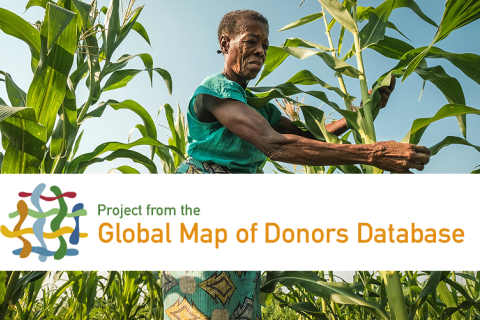The Global Donor Platform for Rural Development is a network of 38 bilateral and multilateral donors, international financing institutions, intergovernmental organisations and development agencies.
Members share a common vision that agriculture and rural development is central to poverty reduction, and a conviction that sustainable and efficient development requires a coordinated global approach.
Following years of relative decline in public investment in the sector, the Platform was created in 2003 to increase and improve the quality of development assistance in agriculture, rural development and food security.
// Agriculture is the key to poverty reduction
Agriculture, rural development, and food security provide the best opportunity for donors and partner country governments to leverage their efforts in the fight against poverty.
However, the potential of agriculture, rural development and food security to reduce poverty is poorly understood and underestimated.
Cutting-edge knowledge of these issues is often scattered among organisations, leading to competition, duplication of efforts, and delays in the uptake of best practices.
// Addressing aid effectiveness
Therefore the Platform promotes the principles of the Paris Declaration on Aid Effectiveness, the Accra Agenda for Action for sustainable outcomes on the ground, and the Busan Global Partnership for Effective Development Cooperation.
Increasing aid to agriculture and rural development is not enough. Donors must work together to maximise development impact.
// Adding value
The Platform adds value to its members’ efforts by facilitating the exchange of their development know-how, which consolidates into a robust knowledge base for joint advocacy work.
Working with the Platform, members are searching for new ways to improve the impact of aid in agriculture and rural development.
- An increased share of official development assistance going towards rural development
- Measurable progress in the implementation of aid effectiveness principles
- Greater use of programme-based and sector-wide approaches
- More sustainable support to ARD by member agencies
// Vision
The Platform endorses and works towards the common objectives of its member institutions to support the reduction of poverty in developing countries and enhance sustainable economic growth in rural areas.
Its vision is to be a collective, recognised and influential voice, adding value to and reinforcing the goals of aid effectiveness in the agricultural and rural development strategies and actions of member organisations in support of partner countries.
// Evaluation
Between August and October 2014, the Global Donor Platform for Rural Development underwent an Evaluation. The evaluators interviewed across board focal points (FPs) of member organisations, partner institutions, staff of the secretariat and key agricultural and rural development experts from different organisations involved in the Platform initiatives. KIT reviewed Platform documentation of the past 10 years, online resources and services to complete the assessment.
According to the report, the change in overall global development objectives of the Post-2015 agenda and its sustainable development goals (SDG) will only reiterate the relevance of the Platform’s work in coordinating donor activities. Agriculture and rural development are incorporated in many of the SDGs. The targeted development of appropriate policies and innovative strategies will depend on increased, cross-sectoral cooperation which the Platform stands for. The achievement of the Platform’s objectives of advocacy, knowledge sharing and network facilitation functions remains to be a crucial contribution to agriculture and rural development.
Members:
Resources
Displaying 101 - 105 of 809Regional sustainable Development (Project for Land Management and Sustainable Development in Central America)
General
political consulting, capacity building for agencies responsible for sustainable land use planning and landmanagement
Registration Project
General
The project aims to improve the system of registration of legal rights to immovable property by developing standardized, clear and more efficient registration procedures, and by introducing an improved information management system for the registration offices.
Protection of the biodiversity Sierra Madre Oriental and Golfo de Mexico II (Investments & Fund)
General
The FC project plans to strengthen ten terrestrial and two marine reserves as well as an eco-corridor (Corredor Ecológico Sierra Madre Oriental - CESMO) by investing in infrastructure, equipment and institutional capacities.
Climate change adaptation through biodiversity promotion in Bac Lieu Province, Viet Nam
General
In the context of climate change, the southern coastal region of Viet Nam is one of the globally most at-risk areas. The purpose of the project is to increase the protective effect of coastal forests through the sustainable use of resources and biodiversity promotion. To this end, the relevant government agencies will be enabled to tailor their land-use planning to the probable consequences of climate change. The elaboration of adapted management strategies in agriculture and aquaculture will contribute to securing livelihoods of the coastal population. A broad-based awareness-raising campaign through environmental education programmes at schools, combined with the secure establishment of the two focal areas ‘biodiversity promotion’ and ‘climate change adaptation’ in the planning and administrative procedures for coastal zone management at provincial level, has innovative character for the region.
Integrated Water Resources Management - Akhouryan River I (Project Phase 2)
General
The goal of the first phase of the project is to make sustainable the use of the scarce resource water along the Akhouryan River, taking into account various competing interests. Consistent water availability (even in dry years), because of the new water storage system and its integration into a coordinated water management plan, should reduce the vulnerability of the target group and ecosystems to the effects of climate change. In addition, by addressing the needs of surrounding ecosystems (Lake Arpi National Park, Wetlands, River Ecology), management plans will contribute to the conservation and biodiversity in the region. Finally yet importantly, the rehabilitation and completion of the existing rudimentary dam reduces the risk of dam failure.


